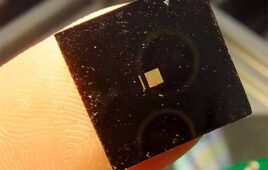
Colored SEM image of nanorobots coated in hybrid platelet/red blood cell membranes. [Image from the University of California San Diego]
The UCSD researchers built the nanorobots using gold nanowires coated with a hybrid of platelet and red blood cell membranes. The hybrid coating meant the nanorobots can perform two different tasks as cells simultaneously. It can perform the tasks of platelets that bind pathogens like MRSA bacteria and red blood cell tats, which absorbs and neutralizes the toxins produced by the bacteria. The gold body part of the nanorobots allows them to be controlled by ultrasound, meaning they can swim around rapidly without the need for chemical fuel.
“By integrating natural cell coatings onto synthetic nanomachines, we can impart new capabilities on tiny robots such as removal of pathogens and toxins from the body and from other matrices,” said Joseph Wang, one of the authors on the study whose team developed the ultrasound-powered nanorobots, in a press release. “This is a proof-of-concept platform for diverse therapeutic and biodetoxification applications.”
The researchers suggest that the nanorobots could one day be used to offer a safe and efficient way to detoxify and decontaminate biological fluids.
“The idea is to create multifunctional nanorobots that can perform as many different tasks at once,” said co-first author Berta Esteban-Fernández de Ávila, a postdoctoral scholar in Wang’s research group at UCSD. “Combining platelet and red blood cell membranes into each nanorobot coating is synergistic—platelets target bacteria, while red blood cells target and neutralize the toxins those bacteria produce.”
Platelet and blood cell membrane coatings also help protect the nanorobots from biofouling, a process that occurs when proteins collect on the surface of foreign objects that prevents them from operating normally.
Wang and his team of researchers developed the hybrid coating by separating entire membranes from platelets and red blood cells. They used high-frequency sound waves to fuse the membranes together and since the membranes were taken from actual cells, they have all their original cell surface protein functions.
At about 25 times smaller than the width of human hair, the gold-coated nanorobots can travel up to 35 micrometers per second in blood when powered by an ultrasound. To test the nanorobots, the researchers used them to treat blood samples that were contaminated with MRSA infections. They also tested it for general use and detoxifying biological fluids.
In the future, the UCSD researchers hope to test the nanorobots in live animals. They also plan to work on making the nanorobots out of biodegradable materials rather than gold.
The research was published in the journal Science Robotics and was supported by the Defense Threat Reduction Agency Join Science and Technology Office for Chemical and Biological Defense.




